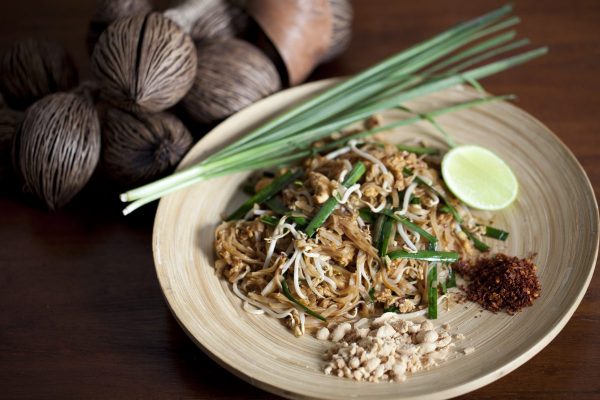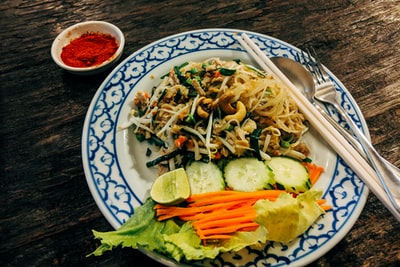Ingredients
- 4 scallions
- 4 bean sprouts
- 2 garlic (cloves)
- 2 eggs
- 1 lime (wedges)
- 1/8 wide
- 525 gr shrimp
- 450 gr rice noodles (dried)
- 120 ml vegetable oil
- 90 ml vinegar (white)
- 75 gr sugar
- 60 ml fish sauce
- 50 gr peanuts (roasted)
- 20 gr chilies (ground roasted)
- 18 gr tomato paste
* The meat used may be either fresh shrimps, chicken, pork, orcombinations. The traditional uses dried shrimps and hard tofu piecesrather than fresh meat.
Soak the noodles for 20 to 25 minutes in enough warm water to cover. Theyshould be soft, but not so soft that they can be mashed easily with thefingers. Later cooking will soften them more. Drain the noodlesthoroughlyin a colander while preparing the other ingredients. Traditionally, theyareleft in full length strands, but you may cut them into shorter lengths(about8-9 inches, say) to facilitate easier stir frying.
Peel and devein the shrimps, leaving the tails intact, OR slice thechicken/pork across the grain into strips not more than 0 cm thick and1-2 inches long.
Mix the fish sauce, sugar, vinegar, and tomato paste in a bowl. Stir untilthe sugar is dissolved. Set the mixture aside. Slice the scallions, bothwhite and green parts, diagonally into pieces 1- half inches long. Setaside.
Heat a wok, and add the vegetable oil to the hot wok. Swirl the oil tocoatthe surface of the wok. Add garlic and fry till golden. Add shrimp andfrytill they turn pink, or if chicken/pork is used, fry till the pink colordisappears completely. Add the noodles and toss lightly to coat them withoil and to distribute the garlic and meat.
Add the liquid mixed earlier and bring to a boil rapidly, gently foldingthenoodle, being careful not to break them. Reduce the heat to medium andboilthe mixture, folding frequently, until the noodles have absorbed theliquid.
Using a wok scoop, or a stiff spatula, lift the noodles gently from onesideof the wok. Pour a little oil along the side of the wok, then break oneeggand slip it into the oil. Break the yolk, and cover the egg with thenoodlesimmediately. Repeat this on the opposite side of the wok with theremainingegg. Allow the eggs to cook undisturbed, over moderate heat, until theyareset and almost dry. Additional oil may be added if the eggs or the noodlesbegin to stick to the wok.
When the eggs are set and almost dry, fold them gently but rapidly into thenoodles. Try not to break the noodles, which will be soft and fragile atthis point. An effective way is to insert the scoop under the eggs, liftit
through, and fold the mixture over.
Continue the lifting and foldingmotionuntil the eggs are broken up and well distributed.
Add the bean sprouts and sliced scallions, and toss the mixture quickly andgently, still avoiding breaking the noodles. Cook for about 2 minutes, oruntil the bean sprouts and scallions are crisp-tender.
Place the mixture on a large, warm serving platter. Sprinkle groundchiliesand peanuts over the top, and squeeze lime juice over that. Alternately,these garnishes may be served on the side for each diner to add accordingto
tastes.
NOTES:
Pad Thai is traditionally served accompanied with freshvegetables,in particular whole scallion, a small pile of fresh raw bean sprouts (to bemixed into the noodles), and if available, a wedge of banana blossom.
For the traditional recipe, omit the shrimps, pork/chicken, and allreferences to them. Substitute half pound very firm tofu and quarter pounddriedshrimps. Put the tofu on a triple layers of paper towels, cover it withanother triple layer, put a plate on top of that, and put a two poundweight(cans of vegetables for an example) on top of the plate. Let stand for 20to
30 minutes to press out the excess water. Put the dried shrimp in a sieve,rinse them quickly under hot running water, and set aside to drain. Afterthe tofu has been pressed, slice it into strips about 1 cm thick, 1 cm wide and 3 cm long.


